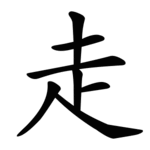| 走 | ||
|---|---|---|
| ||
| 走 (U+8D70) "run" | ||
| Pronunciations | ||
| Pinyin: | zǒu | |
| Bopomofo: | ㄗㄡˇ | |
| Wade–Giles: | tsou3 | |
| Cantonese Yale: | jau2 | |
| Jyutping: | zau2 | |
| Japanese Kana: | ソウ sō (on'yomi) はし-る hashi-ru (kun'yomi) | |
| Sino-Korean: | 주 ju | |
| Hán-Việt: | tẩu, rảo | |
| Names | ||
| Chinese name(s): | 走字底 zǒuzìdǐ | |
| Japanese name(s): | 走/はしる hashiru | |
| Hangul: | 달릴 dallil | |
| Stroke order animation | ||
 | ||
Radical 156 or radical run (走部) meaning "run" is one of the 20 Kangxi radicals (214 radicals in total) composed of 7 strokes.
In the Kangxi Dictionary, there are 285 characters (out of 49,030) to be found under this radical.
走 is also the 150th indexing component in the Table of Indexing Chinese Character Components predominantly adopted by Simplified Chinese dictionaries published in mainland China.
YouTube Encyclopedic
-
1/5Views:3164 979 99513 9789 87010 111
-
NSE #156 | Radical Poetry Reading with Ama Birch & Bennet Bergman
-
He finds Real Life Mermaid... Then This Happens...
-
Juan Carlos Formell y Son Radical perform Llegó La Luna
-
Watch: TODAY All Day - October 30
-
Worship Service | Granite Bay Hilltop SDA Church
Transcription
Evolution
-
Oracle bone script character
-
Bronze script character
-
Large seal script character
-
Small seal script character
Derived characters
| Strokes | Characters |
|---|---|
| +0 | 走 赱 (=走) |
| +2 | 赲 赳 赴 赵SC (=趙) |
| +3 | 赶SC (=趕) 起 赸 |
| +4 | 赹 赺 赻 赼 (=趑) 赽 赾 赿 (=遲 -> 辵) |
| +5 | 趀 趁 趂 (=趁) 趃 趄 超 趆 趇 趈 (=站 -> 立) 趉 越 趋SC (=趨) |
| +6 | 趌 趍 趎 趏 趐 趑 趒 趓 (=躲 -> 身) 趔 |
| +7 | 趕 趖 趗 趘 趙 趚 |
| +8 | 趛 趜 趝 趞 趟 趠 趡 趢 趣 趤 |
| +9 | 趥 趦 趧 |
| +10 | 趨 |
| +12 | 趩 趪 趫 趬 趭 |
| +13 | 趮 |
| +14 | 趯 趰 |
| +16 | 趱SC (=趲) |
| +19 | 趲 |
Sinogram
As an independent sinogram 走 is one of the Kyōiku kanji or Kanji taught in elementary school in Japan.[1] It is a second grade kanji[1].
References
- ^ a b "The Kyoiku Kanji (教育漢字) - Kanshudo". www.kanshudo.com. Archived from the original on March 24, 2022. Retrieved 2023-05-06.
Further reading
- Fazzioli, Edoardo (1987). Chinese calligraphy : from pictograph to ideogram : the history of 214 essential Chinese/Japanese characters. calligraphy by Rebecca Hon Ko. New York: Abbeville Press. ISBN 0-89659-774-1.
- Lunde, Ken (Jan 5, 2009). "Appendix J: Japanese Character Sets" (PDF). CJKV Information Processing: Chinese, Japanese, Korean & Vietnamese Computing (Second ed.). Sebastopol, Calif.: O'Reilly Media. ISBN 978-0-596-51447-1.




